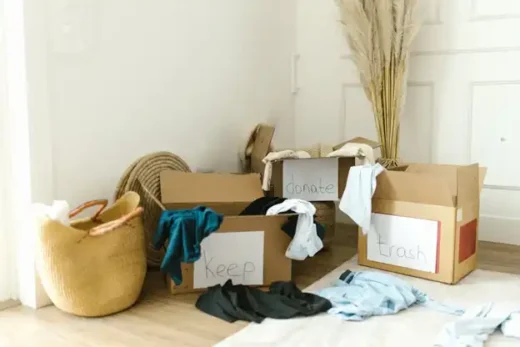Seamless move-out USA, home moving company guide, United States of America house move relocation tips
From Chaos to Calm: Architect-Approved Strategies for a Seamless Move-Out
June 6, 2025
Moving out sounds simple—until the boxes pile up, timelines collide, and you’re stuck wondering where your charging cables disappeared to. Whether you’re a tenant saying goodbye to a beloved rental or an architect wrapping up a client’s property transition, the move-out process has the potential to go off the rails. But it doesn’t have to.
Much like good design, a smooth exit depends on structure, intention, and the right people behind the scenes. That’s why smart planners often turn to a local moving company in Arlington VA to avoid the last-minute scrambles that turn a calm goodbye into pure chaos. With a little foresight and a few architect-approved tactics, your move-out can run like clockwork—clean, clear, and stress-free.

Photo by RDNE Stock project from Pexels
Design the Exit: Planning Like a Pro
Architects don’t dive into a build without a blueprint—and you shouldn’t dive into a move-out without a plan. The first step to a seamless departure is treating it like a mini project with phases, deadlines, and responsibilities. Here’s how to break it down.
Walk the Space with Fresh Eyes
Start with a pre-move assessment. Walk through each room as if you were the property manager inspecting it. What needs fixing? What’s being left behind? What stays until the last day?
Make a list of tasks for each space—patch holes in walls, remove hooks, clean out drawers. It’s easy to overlook these when you’re in packing mode, so get ahead of them early.
Create a Countdown Calendar
Map out a timeline starting at least four weeks before your move. Assign specific tasks to each week:
- Week 4: Sort and purge
- Week 3: Gather supplies, start packing non-essentials
- Week 2: Confirm mover details, handle change-of-address forms
- Week 1: Pack essentials, disassemble furniture, clean appliances
- Move-out day: Final sweep, handover, celebrate surviving it all
This structure keeps the chaos in check and gives you a visual way to track progress.
Pack with Purpose, Not Panic
Most move-out stress stems from packing gone wrong—too much stuff, too little time, and zero system. Architects love labeling blueprints. You should love labeling boxes.
Zone Your Belongings
Pack room by room. Don’t mix your office supplies with your kitchen gear just because they fit in the same box. When each box has a clear destination, unpacking is a breeze and loading the truck becomes a logic puzzle you can actually solve.
Label Like a Designer
Skip vague labels like “misc.” Instead, use big, bold lettering with the room name and key contents. Bonus points for color-coded tape for each room—blue for bathroom, red for kitchen, green for bedroom. Your movers (and future self) will thank you.
Build a “Last Box In, First Box Out”
This box should hold the absolute essentials: tools, chargers, coffee maker, trash bags, a roll of toilet paper. It’s your survival kit. It goes on the truck last and comes off first. Think of it as your architectural site office—in a box.
Don’t DIY the Heavy Lifting (Unless You Want a Hernia)
Even if you’re a pro at project management, that doesn’t mean you should take on every job yourself. Knowing when to outsource is a skill, especially when timelines are tight and stress is high.
Let the Pros Handle Logistics
Good movers do more than transport your stuff. They optimize truck loading, protect fragile items, and navigate tight stairwells and loading zones like pros. That means fewer broken items, fewer delays, and no sore backs the next morning.
Look Local for an Edge
A local crew knows the quirks of Arlington—whether it’s parking permits, traffic bottlenecks, or elevator schedules in downtown buildings. That local knowledge helps shave off hours from your move-out process.
Make Clean-Up Part of the Plan, Not an Afterthought
Here’s the part people forget: leaving a space spotless isn’t just about getting your deposit back. It’s about respect—for the next tenant, the property manager, and the building itself.
Purge, Then Pack
Don’t move what you don’t need. Donate, sell, recycle. The fewer items you take, the less time, space, and money you’ll burn. Plus, decluttering is one of the easiest ways to make a move feel lighter (mentally and physically).
Schedule a Cleaning Crew—or Set Aside Time to DIY
Whether you book a professional cleaner or block out a few hours to scrub yourself, make sure it’s on your calendar. Clean floors, baseboards, bathrooms, inside cabinets, and appliances. Architects know details matter. The same goes for move-outs.
Communicate Like You’re Running a Construction Site
Moves, like construction jobs, fall apart when people stop communicating. Keep everyone in the loop—whether it’s your roommates, movers, or property manager.
Confirm All the Details
Send a final confirmation to your movers 48 hours ahead of time. Confirm the arrival window, addresses, any fragile items, and building requirements (e.g., elevator reservations). It saves everyone a headache.
Give Your Building a Heads-Up
If you’re in an apartment or condo, check whether your building requires move-out notification. Some have strict move-out hours, elevator bookings, or insurance requirements. Get that sorted early to avoid last-minute panic.
Watch Out for Common Move-Out Mistakes
Even the most carefully planned moves can go sideways if you fall into these traps:
- Underestimating how long packing takes
Spoiler alert: It always takes longer than you think. Start early. - Forgetting to measure large furniture
Will that giant couch fit through the door? Down the stairs? Into the elevator? Measure twice, regret never. - Not labeling cables and parts
Label cords and bag up hardware (screws, bolts, etc.) for furniture disassembly. Tape it to the item if needed. - Leaving “just a few things” for the last day
Those few things always turn into an avalanche. Don’t leave them for your future self to deal with.
What Architects Can Teach Us About Moving Out
At the end of the day, the smoothest move-outs borrow principles straight from architecture and design:
- Form follows function: Don’t just pack what looks good—pack for how things will be unpacked and used.
- Structure creates calm: Timelines and lists may sound boring, but they’re lifesavers under pressure.
- Every project has a punch list: Leave time at the end for final fixes, cleaning, and walkthroughs.
- Collaboration is key: You don’t build a home solo. Why move out that way?
Final Walkthrough: What to Check Before You Lock Up
As your movers drive away and the space echoes with emptiness, do a last pass through the property. Look for these often-missed spots:
- Inside kitchen drawers and cabinets
- Dishwasher and oven (yes, people forget items inside)
- Closets, especially top shelves
- Bathroom cabinets and shower racks
- Behind doors, under beds, and in the corners
Leave a note and keys where required, and snap a few photos for your records—especially if you’re expecting a security deposit back.

Photo by cottonbro studio from Pexels
Closing Thoughts: Leave Like You Designed It
Moving out doesn’t have to feel like a demolition zone. When done with care, it can be a satisfying punctuation mark on a life chapter—or a smooth handoff between projects. Whether you’re a design enthusiast or just someone trying to get through it all with your sanity intact, a little structure goes a long way.
And if you’re lucky enough to partner with a reliable local moving company in Arlington VA, even better. They’ll handle the heavy lifting while you focus on making your exit as smooth as your entrance.
Comments on this guide to Seamless move-out USA, home moving company article are welcome.
American Architecture Designs
American Architectural Designs – selection:
Nancy and Rich Kinder Building Houston
Design: Steven Holl Architects
Commonwealth Pier Boston
Design Architect: Schmidt Hammer Lassen Architects
Moving Home Articles
House Moving Posts
Right service for your move to a new home
Comments / photos for the Seamless move-out USA, home moving company guide page welcome






